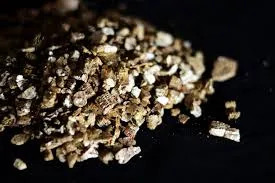Vermiculite is a popular soil additive for houseplants and garden plants that improves soil texture and helps to grow healthy plants. The main benefits of adding vermiculite to soil are better water absorption, retention, and drainage of the soil, thereby regulating the amount of water available to plants.
Read on to learn what vermiculite is, how to use it, and how it compares to perlite.
What is Vermiculite?
Vermiculite is a mica-like mineral that serves as a soil amendment. It is mined out of the ground, exfoliated, and treated with extreme heat and pressure. The resulting worm-like, curly, and sterile product has the ability to expand.
The silvery-gray and flaky material is so light that the small particles move when you blow on them. Vermiculite traps nutrients in the soil but it does not contain any nutrients; it has to be mixed with commercial fertilizer or compost to feed plants.
How Vermiculite Works in Soil
The material is able to expand, and it is sterile and non-toxic—all traits that are important to gardeners. It is the ability of vermiculite to expand that lets it retain moisture in the soil. Its porous surface and unique shape also trap nutrients for plants to access as needed. Vermiculite lightens heavy soils, providing a more conducive environment for plant roots. Because it is sterile, gardeners don’t have to worry about it harboring harmful plant pathogens. Vermiculite won't deteriorate in the soil, meaning it lasts a long time.
Benefits of Using Vermiculite in Soil
Vermiculite is a useful addition to soil for various reasons:
- It is lightweight, a property that is especially important for potted plants.
- It is highly absorbent. Its particles absorb and retain water and nutrients and make them available to the plants whenever they need them.
- It has a neutral soil pH so gardeners don’t have to be concerned about altering the soil acidity by adding vermiculite.
Disadvantages of Using Vermiculite in Soil
When using vermiculite in soil, keep in mind the following cons:
- Vermiculite is mined from the earth and a nonrenewable resource.
- It can be challenging to mix and distribute evenly.
- Vermiculite emits dust which can cause irritation.
- It can be too porous, causing blockages in the soil or the entrapment of debris and algae.
How to Use Vermiculite in Soil
This versatile mineral product has many different uses. They include:
- Improving drainage: Vermiculite is added to improve the soil texture of heavy clay soil that is waterlogged because of poor drainage.
- Improving water retention: Adding vermiculite also improves the soil texture of sandy soil that drains too fast and does not retain enough water.
- Seed starting: Vermiculite as the sole material or in a potting mix makes a good, lightweight medium for seed germination. It also benefits seedling development because water is available to the plants when they need it.
- Addition to potting soil: Mixing vermiculite into the potting soil for container plants helps to improve drainage and moisture retention.
- Soilless potting mix: Instead of buying a commercial soilless potting mix, make youre own by mixing 4 to 6 parts sphagnum peat moss, 1 part perlite, and 1 part vermiculite.
- Rooting cuttings: To get cuttings rooted, vermiculite as the sole material or in combination with other lightweight materials such as in a soilless potting mix, is ideal because new tender roots can easily anchor.
- Storing bulbs, root crops, and plants for indoor overwintering: Vermiculite makes an ideal storage medium as it absorbs any moisture that might cause decay.
- Newly seeded lawns: A 1/4-inch layer of vermiculite helps keep grass seed from drying out while it germinates.
Vermiculite vs. Perlite
Perlite is that white material in soilless potting mixes that looks like little chunks of styrofoam. In its natural state, it has a pearl-like shine to it that accounts for the name, "perlite." While vermiculite and perlite are two completely different substances, they do have some things in common. Both are:
- mined out of the ground (perlite is a volcanic mineral)
- later heated, causing them to expand
- used as soil amendments, both in soilless potting mixes indoors and to improve garden soil outdoors
- lightweight
- sterile
- have a neutral pH
- contain no nutrients
But whereas vermiculite is especially valued for its capacity to retain water, the value of perlite lies much more in its ability to provide aeration.
When to Choose Vermiculite vs. Perlite
The answer to the question of when to use vermiculite vs. perlite is pretty straightforward. Because the moisture retention capacity of vermiculite is superior to that of perlite, use vermiculite when this property is key. These applications include:
- In a growing medium for plants that dry out easily. Add more vermiculite than perlite when mixing your own growing medium.
- For seed starting indoors. There are different grades of vermiculite, choose the finest for seed starting.
- In a growing medium for root cuttings. Being finer than perlite, vermiculite is more conducive to root growth (select medium-grade vermiculite for this purpose).
Perlite, on the other hand, does a good job at improving aeration. Therefore, it is best used in a growing medium for plants that don’t mind drying out but need outstanding drainage. Add more perlite than vermiculite (or exclusively perlite) to your mix when you are creating a growing medium for plants such as cacti and other succulents.

